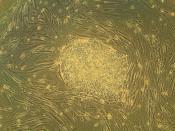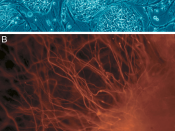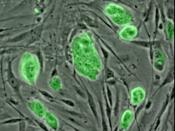Stem cells are the primal cells found in all multi-cellular organisms. They have the remarkable potential to develop into many different cell types in the body. Serving as a sort of repair system for the body. They can theoretically divide without limit to replenish other cells through mitotic cell division as long as the person or animal is still alive. When a stem cell divides, each new cell has the potential to either remain a stem cell or become another type of cell with a more specialized function, such as a muscle cell, a red blood cell, or a brain cell.
There are three broad categories of stem cells they are: embryonic stem cells, derived from blastocysts, adult stem cells, which are found in adult tissues, and cord blood stem cells, which are found in the umbilical cord. In a developing embryo, stem cells can differentiate into all of the specialized embryonic tissues.
In adult organisms, stem cells and progenitor cells which act as a repair system for the body, replenishing specialized cells.
Stem cells were really first discovered almost fifty years ago by a man named Leroy Stevens. When he was working at the Jackson Laboratory in Bar Harbour, he found a lab mouse with unusually enlarged scrotum. When he examined the mouse, he discovered that there had been a tumour inside of its scrotum that contained various tissues, including those of hair and teeth. He traced the origins of the tumour to a stem cell. Yet the field of stem cells only took off after Canadian scientists Ernest A. McCulloch and James E. Till in the 1960s examined it.
Now in modern days Research on stem cells is advancing now more than ever with scientists extending their fields of scientific enquiry to gain more knowledge about how and...


